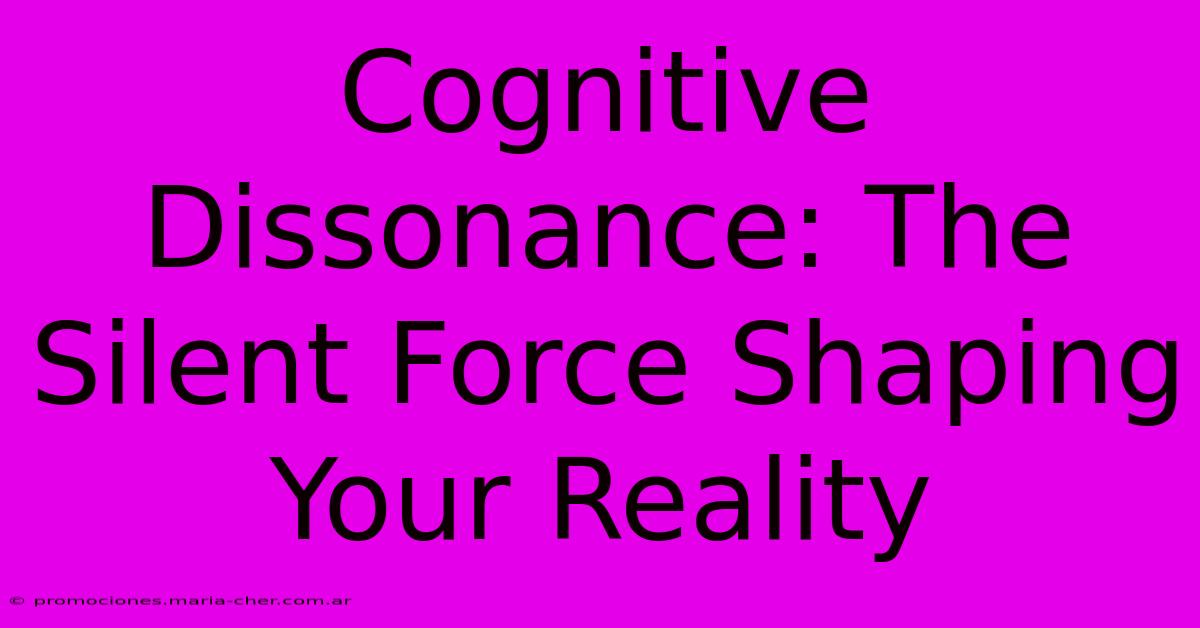Cognitive Dissonance: The Silent Force Shaping Your Reality

Table of Contents
Cognitive Dissonance: The Silent Force Shaping Your Reality
Cognitive dissonance. It's a term that might sound intimidating, but it's a powerful psychological concept that profoundly impacts our daily lives. Understanding it can unlock a deeper understanding of your own behavior and the behaviors of those around you. This article will delve into the fascinating world of cognitive dissonance, explaining what it is, how it works, and how you can harness its power for positive change.
What is Cognitive Dissonance?
Cognitive dissonance is the mental discomfort experienced by a person who holds two or more contradictory beliefs, ideas, or values. This discomfort arises when we act in a way that conflicts with our self-image or our deeply held beliefs. Think of it as your brain's internal alarm system, going off when it detects an inconsistency. This inconsistency creates a state of tension, motivating us to reduce that discomfort.
Examples of Cognitive Dissonance in Action:
- The Smoker's Dilemma: A smoker knows that smoking is harmful to their health (belief 1), yet they continue to smoke (action). This creates dissonance. To reduce the discomfort, they might downplay the risks of smoking, rationalize their habit, or even become defensive when confronted about it.
- The Buyer's Remorse: You purchase an expensive item, only to later question whether it was worth the money. This dissonance arises from the conflict between the expense (action) and the potential regret (belief). To resolve it, you might focus on the positive aspects of the purchase, minimizing the negative ones.
- The Charitable Hypocrite: Someone who believes strongly in charity but rarely donates might experience dissonance. To resolve this, they might justify their inaction by claiming they'll donate "later" or focusing on other ways they contribute to society.
How We Reduce Cognitive Dissonance
Our minds are incredibly adept at minimizing this discomfort. We employ several strategies:
- Changing our beliefs: We might adjust our beliefs to align with our actions. For example, the smoker might start believing that the health risks are exaggerated.
- Changing our actions: We might alter our behavior to match our beliefs. The smoker might quit smoking.
- Adding new beliefs: We might justify our actions by adding new beliefs that rationalize the inconsistency. The smoker might believe that stress relief outweighs the health risks.
- Downplaying the importance of the conflict: We might minimize the significance of the inconsistency. The smoker might believe that everyone dies eventually, so smoking isn't that big of a deal.
The Power of Cognitive Dissonance in Persuasion
Understanding cognitive dissonance can be a powerful tool for persuasion. By creating a state of dissonance in someone, you can subtly influence their behavior or beliefs. For instance, a marketer might highlight the negative consequences of not buying a product to create dissonance and motivate a purchase.
Harnessing Cognitive Dissonance for Personal Growth
Cognitive dissonance isn't always negative. It can be a catalyst for personal growth and positive change. By acknowledging the dissonance you feel and actively working to resolve it, you can identify areas where your beliefs and actions are misaligned. This self-awareness can lead to more authentic and fulfilling life choices.
Overcoming Cognitive Dissonance: A Practical Guide
- Become self-aware: Pay attention to your thoughts and feelings. Identify situations where you experience cognitive dissonance.
- Challenge your beliefs: Ask yourself if your beliefs are truly justified or if you're rationalizing to avoid discomfort.
- Accept responsibility: Take ownership of your actions and their consequences.
- Seek out diverse perspectives: Expose yourself to different viewpoints to challenge your own biases.
- Embrace discomfort: Allow yourself to feel the dissonance. It's a sign that you're growing and changing.
Cognitive dissonance is a fundamental aspect of human psychology. It's a silent force shaping our perceptions, decisions, and ultimately, our reality. By understanding how it works, you can gain valuable insights into your own behavior and the behavior of others, paving the way for greater self-awareness and personal growth. Learning to manage and even utilize cognitive dissonance can be a powerful tool for positive change in your life.

Thank you for visiting our website wich cover about Cognitive Dissonance: The Silent Force Shaping Your Reality. We hope the information provided has been useful to you. Feel free to contact us if you have any questions or need further assistance. See you next time and dont miss to bookmark.
Featured Posts
-
Unveiling The Enigmatic Symbols Of Visconti Sforza A Guide To Self Discovery
Feb 07, 2025
-
Elevate Your Visuals With Lumis Cutting Edge Ai The Future Of Photography Unlocks
Feb 07, 2025
-
From Day To Night Gold Vermeil Bracelets For Every Occasion
Feb 07, 2025
-
Revelado El Secreto Para Convertir Webp A Jpg Sin Sacrificar La Calidad
Feb 07, 2025
-
Divine Your Path With Visconti Sforza The Ultimate Tarot Companion
Feb 07, 2025
